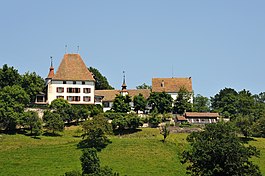Burgistein
| Burgistein | ||
|---|---|---|

Burgistein Castle
|
||
|
||
| Coordinates: 46°47′N 7°30′E / 46.783°N 7.500°ECoordinates: 46°47′N 7°30′E / 46.783°N 7.500°E | ||
| Country | Switzerland | |
| Canton | Bern | |
| District | Thun | |
| Area | ||
| • Total | 7.53 km2 (2.91 sq mi) | |
| Elevation | 763 m (2,503 ft) | |
| Population (Dec 2015) | ||
| • Total | 1,063 | |
| • Density | 140/km2 (370/sq mi) | |
| Postal code | 3664 | |
| SFOS number | 0863 | |
| Surrounded by | Gurzelen, Kirchdorf, Lohnstorf, Noflen, Riggisberg, Rüti bei Riggisberg, Seftigen, Wattenwil | |
| Website |
www SFSO statistics |
|
Burgistein is a municipality in the administrative district of Thun in the canton of Bern in Switzerland.
Burgistein is first mentioned in 1266 as Burgstein and in 1271 as Burgenstein.
The oldest traces of a settlement in the area include scattered neolithic artifacts and Roman coins. During the Early to High Middle Ages there was a hill fort on Bühlhölzli hill. Across from Bühlhölzli, on Schönegg hill, are the ruins of Blankenberg Castle, which was demolished in the second half of the 14th century. During the 13th century, Jordan I of Thun began buying up farming villages and land in the Gürbetal and surrounding valleys. In 1260 he combined the scattered estates into a Herrschaft and built Burgistein Castle. By 1266 he was calling himself Jordan von Burgistein after the castle. In 1340, after the Bernese victory in the Battle of Laupen in the previous year, Burgistein Castle was destroyed in retaliation for Burgistein support against Bern. The castle was rebuilt several years later. In 1397 the Burgistein family died out and the castle was inherited by Werner Münzer. Over the following century it passed through numerous owners until 1484 when the Bernese Schultheiss Jakob von Wattenwyl acquired it. The Wattenwyl family owned the castle until 1714, when it passed to the Graffenried family. The 14th-century castle was rebuilt in the 15th and 16th centuries.
Burgistein has always been part of the parish of Thurnen, even after the village church was built in 1959.
Beginning in the 1970s the municipality began to gradually change from farming communities into bedroom communities for the nearby cities of Bern and Thun.
...
Wikipedia




